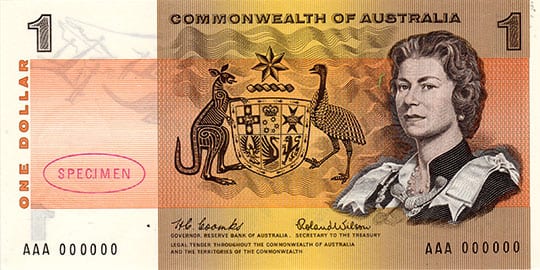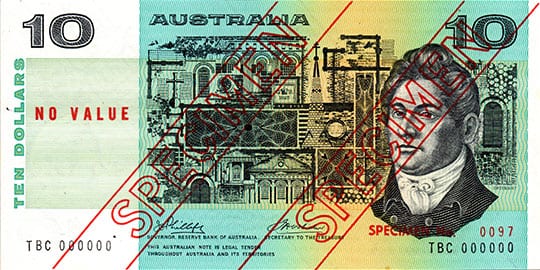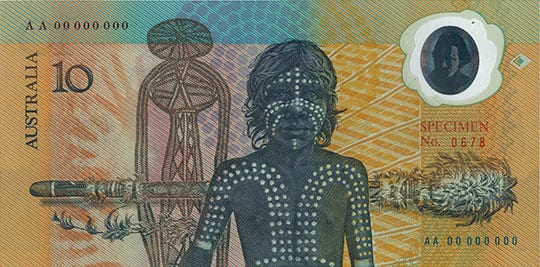Articles
A History of Australian Specimen Banknotes
Australian Pre Decimal Banknotes circa 1913-1961
The first Australian specimen banknotes were issued by The Treasury of the Commonwealth of Australia Circa 1913-1915. These banknotes came from the normal printing run of each denomination, they carried the word CANCELLED perforated horizontally near the centre on the obverse side of each banknote. The signature combinations of Australia’s first specimen banknotes were both Collins/Allen and Cerutty/Collins.
In the TS Harrison (Commonwealth of Australia Printer) era, banknote issues from 1923 to 1933, two large holes were added, also during this period, distinct black diagonal lines were added to both the obverse and reverse sides.
With the introduction of the Riddle/Sheehan signatures combinations from 1933, banknotes continued to have a large CANCELLED perforation, together with five distinct circular holes.
Later specimen banknotes consisted of a smaller CANCELLED perforated on the obverse side, in the signature area, together with black diagonal lines. Exceptions to this rule were made for specimen banknotes presented to King George V and the Prince of Wales; these are referred to as the Prince of Wales specimen banknotes. These banknotes were the first Australian banknotes to carry the word SPECIMEN, which were placed within the serial number area of the banknote.
Banknotes with a small perforated CANCELLED together with black lines, were to continue through the King George V and King George VI, and the first Queen Elizabeth II banknote issues circa 1954.
After this year, the Treasury of the Commonwealth of Australia, specimen banknotes were changed to large capped SPECIMEN, printed in red, this was printed on both sides of these banknotes.
Decimal Specimen Banknotes – Type 1

With the introduction of decimal currency in February 1966, specimen banknotes featured the word SPECIMEN in bold red lettering, surrounded by an oval configuration in red. All Type 1 specimens as they are referred to, as they were the first decimal SPECIMEN banknotes issued in 1966, carried the first prefix of each banknote with the serial number 000000. Type 1 specimens which all carried the signature combination of Coombs/Wilson, were- One Dollar AAA 000000, Two Dollar FAA 000000, Five Dollar Coombs/Randall NAA 000000 issued separately on issue in 1967, Ten Dollar SAA 000000 and finally the Twenty Dollar XAA 000000.
The type 1 set of specimen banknotes was produced in a book form. The total of 208 books was issued containing 2 banknotes of each denomination. These books were produced for presentation to dignitaries, major banks both within Australia and internationally, libraries both in Australia and internationally and individuals associated with the design and production of the introduction of decimal currency to Australia.
Of the 208 books, over many years quite a number changed hands, new owners would break these books down, and sell the SPECIMEN banknotes on the open market.
This is the reason collectors and investors are able to purchase individual Type 1 SPECIMEN banknotes.
As all SPECIMEN banknotes were gifted to certain institutions, and individuals, a profit was to be made, and realised, thereby the commencement of an open market in decimal specimen banknotes.
Decimal Specimen Banknotes – Type 2
Decimal specimen type 2 banknotes had the word SPECIMEN printed diagonally in red eight times there were four overprints on the obverse side and four on the reverse side.
All banknotes commenced with the first prefix, with the serial number 000000. These specimen banknotes were issued to Australian and International banks to display these new banknotes to the general public. Those that were put on display by Australian for public viewing, will normally have pin holes on the banknote, this is common. Many banknotes never ‘quite made it to a public notice board’, within Australian banks, and from time to they appear at auction in Uncirculated condition.
The signature combinations of Type 2 specimen banknotes in their denominations were all the signature combination of Coombs/Wilson from One Dollar to Twenty Dollar, coupled with the Five Dollar Coombs/Randall, with first prefix and serial numbers 000000. In addition to the above listed Type 2 specimen banknotes were the signature combinations of Phillips/Wheeler circa 1972.
Historical Notation
Only two full sets and two singles are known to exist in the 8BY specimen overprint, with the signature combination of Phillips/Wheeler-Commonwealth of Australia. The Type 2 SPECIMEN issue of 10 banknotes is described as extremely rare. Having been issued to Australian banks, and as with all specimen banknotes, they may have been destroyed, or kept as mementos by bank staff.
Rarity
Of all issued Australian specimen banknotes-Type 2 are the rarest. As only issued to banks for public display, with a small number allocated to those involved in the design and production of the banknotes. Type 2 banknotes are very rarely seen on the open market in strictly uncirculated grades.
Due to the rarity of Type 2 SPECIMEN banknotes appearing on the open market, sale prices exceed all other decimal specimen banknotes by a ratio of 7 to 1.
Decimal Specimen Banknotes – Type 3

Specimen banknotes issued in Type 1 and Type 2, all have the same serial numbers, this being all identified by first prefix and serial numbers 000000. There was no way of tracking individual banknotes.
Type 3 specimen banknotes, included the words “NO VALUE”. Two large diagonal words in outlined type denoted SPECIMEN, with the additional security feature, giving the actual specimen number. These security features were added to both the obverse and reverse sides.
Similar security overprinting is now used on Australian pre decimal banknotes loaned to major museums and banks throughout the world, remembering all Australian specimen banknotes, in theory remain the property of the Australian government in perpetuity.
Decimal Specimen Banknotes – Type 4

The decimal Type 4 banknote, a One Hundred Dollar with the signature combination of Johnston/Stone circa 1984.
Obverse side small Red SPECIMEN, underneath the figures of Tebbutt and Mawson at the top of the banknote, was printed twice, this is repeated once on the reverse side. This new specimen type was introduced in 1984, with the introduction of the first Australian One Hundred Dollar banknote in 1984. The specimen number was printed in red on the reverse side for security reasons.
Historical Notation
Cardholders containing one specimen banknote were autographed by the designer Harry Williamson. As specimen banknotes are produced primarily for use within and by The Reserve Bank of Australia, and gifted to overseas banks. The Reserve Bank according to research is not prepared to divulge details about, the number of this very rare banknote being issued.
Decimal Specimen Banknotes – Type 5. Paper/Polymer Banknote Issues.
The introduction of polymer banknotes, commenced with the Ten Dollar Bi-Centennial with the signature combination of Johnston/Fraser.
The banknote featured a small Red Specimen on the obverse side, with the SPECIMEN number on the reverse side of the banknote. This series of numbering of all polymer banknotes with individualised serial numbers has been continued for all polymer banknotes from 1988. Serialised numbers were added from Type 3 specimens to protect the integrity of genuine specimen banknotes.
Reference Sources
Michael P Vort Roland. Australian Specimen Banknotes. December 2012.
Renniks Australian & Banknote Values 24th Edition.
McDonald, Australian Coins and Banknotes. Twentieth Edition.
RE. Fahy Pty Ltd Historical and Research Department.
Copyright: RE Fahy Pty Ltd. 2013.
